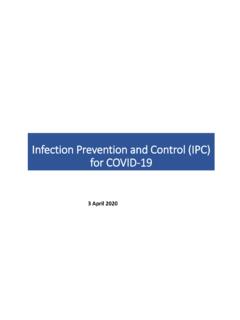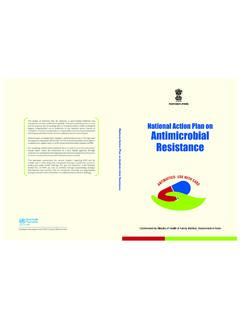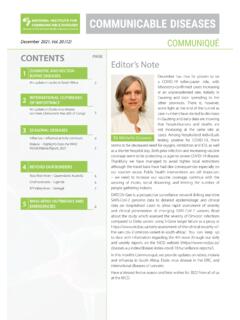Transcription of National Treatment Guidelines - COVID19 India
1 National Treatment Guidelines for Antimicrobial Use in Infectious Diseases National CENTRE FOR DISEASE CONTROL Directorate General of Health Services Ministry of Health & Family Welfare Government of India Version (2016) 2 CONTENTS Chapter 1 .. 7 Introduction .. 7 Chapter 2.. 9 Syndromic Approach For Empirical Therapy Of Common 9 A. Gastrointestinal & Intra-Abdominal Infections .. 10 B. Central Nervous System Infections .. 13 C. Cardiovascular Infections .. 14 D. Skin & Soft Tissue Infections.
2 15 E. Respiratory Tract Infections .. 16 F. Urinary Tract Infections .. 17 G. Obstetrics And Gynaecological Infections .. 18 H. Bones And Joint Infections .. 22 I. Eye Infections .. 23 J. Ear Infections .. 25 K. Infections in Burn and Plastic Surgery .. 26 L. Fungal Infections .. 27 M. Febrile Neutropenia .. 27 N. Post-Cardiovascular Surgery Infections .. 29 O. Pediatric Infections .. 31 P. Neonatal Infections .. 39 R. Post Solid Organ Transplant .. 40 S. Surgical Antimicrobial Prophylaxis .. 41 Chapter 3.
3 42 Treatment Of Muti-Drug Resistant Bacterial Pathogens .. 42 1. Methicillin- Resistant S. aureus (MRSA) .. 42 2. Vancomycin Resistant Enterococcus (VRE) .. 42 3. Extended Spectrum eta-Lactamases (ESBL) Producing Enterobacteriaceae.. 42 4. Carbapenem- Resistant Enterobacteriaceae (CRE) .. 42 Chapter 4 .. 44 Guidelines For Optimizing Use Of Key Antimicrobials .. 44 A. Antimicrobial Prescribing: Good Practice .. 44 B. Reserve Antimicrobials .. 45 C. Hypersensitivity .. 45 D. Alert 46 E. Alert Antibiotics And Their Indications.
4 46 Chapter 5 .. 49 Preventive Strategies For Healthcare Associated Infections .. 49 A. Healthcare Associated Infections .. 49 B. Reducing the risk of Health care associated 49 Chapter 6 .. 50 Monitoring Antimicrobial Use .. 50 A. Background .. 50 B. Need For Surveillance To Track Antimicrobial Use And Resistance .. 50 C. Standardized Methodology And Outcome Measures .. 50 D. Situation In Developing Countries .. 51 High-end Antibiotic Monitoring Sheet .. 52 Surgical Prophylaxis Monitoring Sheet .. 52 Chapter 7.
5 53 Dosage Guide For Commonly Used Antimicrobial Agents .. 53 Chapter 8 .. 57 Link To National Programme Current Guidelines For Treatment Of Specific 57 Chapter 9 .. 59 Case Definitions And Diagnosis For Common Infections .. 59 DIARRHEA .. 59 ENTERIC FEVER .. 59 SPONTANEOUS BACTERIAL PERITONITIS .. 59 ACUTE PANCREATITIS .. 59 ACUTE BACTERIAL MENINGITIS .. 60 BRAIN ABSCESS .. 60 INFECTIVE ENDOCARDITIS .. 60 CELLULITIS .. 61 FURUNCULOSIS .. 61 URINARY TRACT INFECTIONS .. 61 PNEUMONIA .. 61 ABBREVIATIONS.
6 63 3 4 5 6 7 Chapter 1 INTRODUCTION Infections caused by microorganisms have threatened human life since time immemorial. During the pre-antibiotic era, these have been a major concern for the high morbidity and mortality in humans. Some of the virulent organisms with the potential to spread infection from one infected person to another at a very rapid rate may cause worldwide pandemics, epidemics or outbreaks. With the discovery of the first antibiotic, "the magic bullet" Penicillin in the year 1943, patients could be effectively cured of many life-threatening infections.
7 This gave a huge relief to the medical practitioners. Next three decades saw the development and discovery of a wide variety of antimicrobial agents. Subsequently, the pace of discovery of newer molecules declined from 1970 to 1987. It has reached a discovery void level from 1987 onwards up till now. This is the post-antibiotic era in which the medical practitioners have to treat and manage all types of infections with equal or greater efficiency. Spontaneous natural development of antimicrobial resistance in the microorganisms in nature is a slow process.
8 However, the frequent and inappropriate use of a newly discovered antimicrobial drug leads to the development of altered mechanisms in the pathophysiology of the concerned microbes as a survival strategy. Such antibiotic selection pressure kills the susceptible microbes and helps in selective replication of drug resistant bacteria. These resistant bacteria already existed in the population along with the susceptible ones or susceptible bacteria acquired resistance during antimicrobial Treatment .
9 Ultimately, such resistant bacteria multiply abundantly and entirely replace the susceptible bacterial population. This results in Treatment failure or ineffective management of such infected patients. Antimicrobial resistance has been observed and reported with practically all the newly discovered antimicrobial molecules till date. Antimicrobial resistance makes the Treatment of patients difficult, costly and sometimes impossible. Emergence of antimicrobial resistance in pathogens has become a matter of great public health concern.
10 Antimicrobial resistance is well recognised as a global threat to human health. Infections caused by antimicrobial-resistant micro-organisms in hospitals are associated with increased morbidity, mortality and healthcare costs. Resistance has emerged even to newer and more potent antimicrobial agents like carbapenems. Selection and spread of resistant microorganisms in the presence of antimicrobials is facilitated by: Irrational use of drugs Self-medication Misuse of drugs Antimicrobial resistance is closely linked to inappropriate antimicrobial use.





